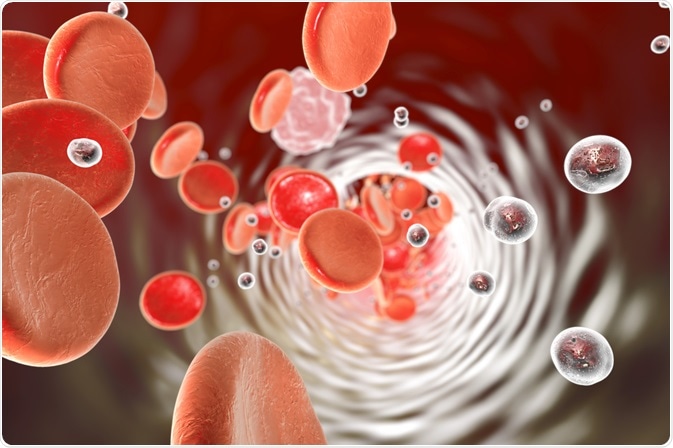In recent years, nanotechnology has been used in a growing number of scientific fields. Many different nanostructures have been proposed and developed, helping to solve problems that previously proved difficult. This article will discuss the use of one of these structures, nanobowls, in the field of medicine.
 Image Credit: Kateryna Kon/Shutterstock.com
Image Credit: Kateryna Kon/Shutterstock.com
What are nanobowls?
In nature, asymmetric structures are common and play vital roles in systems. Nanoparticles that mimic these structures can be constructed in the lab and can be used in a wide variety of applications for many different fields of science. Asymmetrical nanoparticles have been demonstrated to perform well in bioimaging and catalysis, for example.
One such nanostructure which has been developed in recent years is the nanobowl. This is a dense, spherical nanostructure that has a single hole and opening on the surface. This hole is asymmetrically placed. Features of nanobowls that make them especially attractive to researchers in fields such as medicine and energy storage include their concave structure, high packing density, and unique asymmetric cavities.
Different methods exist for preparing nanobowls. These include template methods (which have the drawback of being time-consuming and non-environmentally friendly) and self-assembly of polymers. The formation of nanobowls from small molecules may be governed by solvents rather than their molecular structure and the principles behind their formation are largely unknown. The preparation of nanobowls with controlled openings and interior spaces is still challenging.
Applying nanostructured technology to medicine
The field of medical science is a constantly evolving one. Unique challenges exist in areas such as drug delivery, for example, and the use of nanotechnology has, in recent years, presented a paradigm shift in medical technology. The specific term for the application of nanotechnology to medicine is nanomedicine.
Nanotechnology has provided new applications for drug delivery, gene therapy, therapy development, and has provided new materials for medical technology. Many nanomaterials have been explored over the past few decades.
Magnetically delivering drugs with nanobowls
Specifically targeting diseased areas within the body presents problems for medical science. Traditional drug delivery methods fall far short of this need, so there is a pressing requirement to develop drug delivery methods that perform better. Nanomaterials present one such technological solution.
In a 2016 study published in Nanoscale journal, a team led by Alexander H. Mo demonstrated that gold-coated silica nanobowls could be used to deliver targeted drugs, as well as to detect diseased tissue and cells. Sandwiched between the gold and silica layers is a layer of magnetic iron oxide nanoparticles. The iron oxide layer allows the nanobowls to be controlled with a small magnet.
The gold layer allows for the nanobowls to be easily imaged. Molecules with low concentrations, which would normally be difficult to detect on their own, became much easier to detect when in the presence of the nanobowls. This provides a possibility for the early detection of drug markers.
Using this system for drug delivery also allows for the transport of drugs through places where drugs don’t normally pass, such as the blood-brain barrier. This opens up new ways to target diseases such as Alzheimer’s disease and glioblastomas. Nanobowls can be safely guided through the blood-brain barrier using magnets. Nanobowls can also be taken in by live cells.
Another possibility hinted at by the team in the paper was the construction of caps for the nanobowls, which would allow for controlled drug release once at the target tissue.
Using nanobowls to deliver chemotherapy drugs to cancer cells
For decades, liposomes have been explored as a delivery vessel for chemotherapy drugs. However, there is one drawback to their use. Drugs can sometimes leak out of them before they have reached their destination. This is problematic not only because less of the drug is received by the tumor, but also the chance of harmful side-effects in the tissues is increased.
Researchers have long tried to find a way to stabilize these structures. Approaches such as crosslinking the lipids in their bilayers or coating the surfaces of the liposomes with polymers provide stability but can alter their properties. This makes them interact differently with cells than intended.
Clearly, there needs to be a better way to stabilize them so they can deliver the drugs to the target cancerous cells. One way being explored is by embedding stiff nanobowls in the inner cavity of the liposome. By assembling the lipid bilayer around it, the liposome is supported by the rigid structure of the silica nanobowl. Once at the target, the liposome breaks apart and the drug is released from the nanobowl.
By using this method, the delivery of chemotherapy drugs to target cells is greatly improved, and thus the successful outcome of cancer treatment is also improved significantly.
Using nanobowls as a DNA delivery system
Silica nanobowls have also been explored as potential DNA delivery systems. A 2020 study led by Madhura Som sook to elucidate their effectiveness for this application by designing an efficient in vitro transfection agent which would exploit the unique characteristics of the silica nanobowl. It is hoped that this will provide a new way of providing targeted gene therapy in the future.
In conclusion
Nanotechnology is providing medical science with new solutions for common problems. Nanobowls have been a particular focus of research in drug delivery and will no doubt find more wide-ranging applications in the near future. They represent a cutting-edge solution for the medical sciences and research is ongoing into their continued use for the field.
Further Reading
Last Updated: Apr 19, 2021